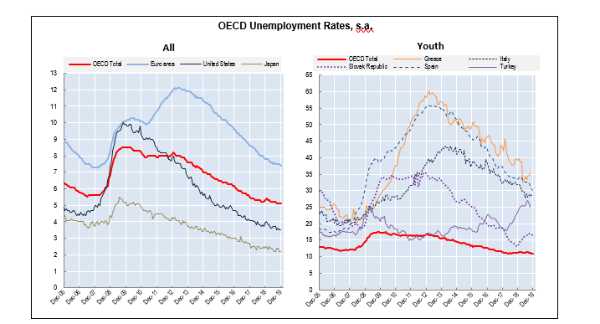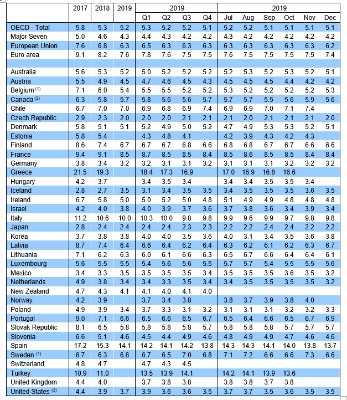OECD Unemployment Rate Stable At 5.1% In December 2019
The OECD unemployment rate remained stable at 5.1% in December 2019. Across the OECD area, 32.6 million people were unemployed, around the level before the financial crisis.
In the euro area, the unemployment rate declined to 7.4% in December (from 7.5% in November), the same level as in April 2008, with declines of 0.3 percentage point in Lithuania (to 6.1%) and the Netherlands (to 3.2%), and increases of 0.2 percentage point or more in Latvia (to 6.7%) and Portugal (to 6.9%).
Outside Europe, the unemployment rate fell by 0.5 percentage point in Israel (to 3.4%) and by 0.3 percentage point in Canada (to 5.6%) and Mexico (to 3.2%), while it increased by 0.2 percentage point in Korea (to 3.8%). The unemployment rate was stable in Japan (at 2.2%) and the United States (at 3.5%). More recent data for January 2020 show that the unemployment rate declined further in Canada (by 0.1 percentage point, to 5.5%), while it increased by 0.1 percentage point in the United States (to 3.6%).
Between December 2018 and December 2019, the unemployment rate declined by 0.2 percentage point across the OECD. Over the same period, the OECD unemployment rate for youth (people aged 15 to 24) decreased by 0.4 percentage point to 10.8% (the lowest level since 2005, the first year when youth unemployment rate data are available for the OECD area as whole). The youth unemployment rate remained above 25% in Greece (in October 2019), Italy and Spain (in spite of year-on-year falls of 3.0 percentage points or more in these three countries) as well as in Turkey, where the youth unemployment rate in October was 3.0 percentage points higher than one year before. The youth unemployment rate also recorded year-on-year increases of 2.0 percentage points or more in Iceland, Hungary (between November 2018 and November 2019), Sweden, Luxembourg and the Slovak Republic.


Notes:
(1)
Breaks in the Labour Force Survey data for Belgium in Q1
2017 and for Sweden in Q3 2018.
(2) Canada: Unemployment
rate for January 2020 was 5.5%.
(3) United States:
Unemployment rate for January 2020 was 3.6%.
Methodological Notes for OECD Harmonised Unemployment Rates News Release
The OECD area unemployment rate is calculated as the total number of unemployed persons in all OECD countries as a percentage of the total labour force (i.e., the unemployed plus those in employment); this is equivalent to an average of unemployment rates of all OECD countries weighted by the labour force of each country. Rates and levels are seasonally adjusted (s.a.).
OECD Database: OECD Short-Term Labour Market Statistics
Country Note: Statistical data for Israel are supplied by and under the responsibility of the relevant Israeli authorities. The use of such data by the OECD is without prejudice to the status of the Golan Heights, East Jerusalem and Israeli settlements in the West Bank under the terms of international law.


 University of Queensland: World-First Immunotherapy Trial To Treat Type 1 Diabetes
University of Queensland: World-First Immunotherapy Trial To Treat Type 1 Diabetes Peace Movement Aotearoa: Global Military Spending Threatens A Liveable Future; Militarism Will Cost Us The Earth
Peace Movement Aotearoa: Global Military Spending Threatens A Liveable Future; Militarism Will Cost Us The Earth NZ Catholic Bishops Conference: Papal Funeral 'Very Beautiful, Very Simple', Cardinal Dew Says
NZ Catholic Bishops Conference: Papal Funeral 'Very Beautiful, Very Simple', Cardinal Dew Says UN News: Indigenous Peoples Sidelined In Global Climate Fight, UN Warns
UN News: Indigenous Peoples Sidelined In Global Climate Fight, UN Warns Ocean Conservancy: Ocean Conservancy Condemns Deep Sea Mining Executive Order
Ocean Conservancy: Ocean Conservancy Condemns Deep Sea Mining Executive Order UNICEF Aotearoa NZ: Increases In Vaccine-Preventable Disease Outbreaks Threaten Years Of Progress, Warn WHO, UNICEF, Gavi
UNICEF Aotearoa NZ: Increases In Vaccine-Preventable Disease Outbreaks Threaten Years Of Progress, Warn WHO, UNICEF, Gavi